Stopette
Until the end of the 1940s, most antiperspirants were sold as creams that were applied with the fingers or liquids that were dabbed on using an applicator or pad. Then, as now, aluminium salts were commonly used but the aluminium salts employed back then tended to irritate the skin and were a major drawback.
See also: Deodorants and Antiperspirants
Jules Montenier
In 1937, Jules Montenier, Inc. began selling a liquid antiperspirant using aluminium chloride as the active ingredient. The company founder and president, Jules Montenier, a cosmetic chemist, had reduced some of the irritating effects of aluminium chloride by buffering it with substances like urea and had taken out a series of patents to protect his ideas (US2230082, 1941; US2230083, 1941; US2230084, 1941).
Montenier packaged his liquid antiperspirant in a soaked flannel pad but a chance discovery in 1939 suggested that the flannel was also a potential source of skin irritation. He first noticed the problem when items were returned by over-stocked merchants and described this finding in an article he wrote for the ‘Drug and Cosmetic Industry’ journal in 1951.
I have always made a practice to examine thoroughly returned merchandise. In the case of these pads, I was amazed to learn that many of them were almost completely dry. I decided to try some of those dried-up pads on myself, and found the next day that I had developed a slight hyperemia. Under the microscope, I could find no appreciable amount of crystalline salt dispersed in the flannel and reasoned that it must be the rubbing of the pad itself, which was partially the cause of the irritation. I repeated the operation another night and created a new redness under my arms. It was obvious that the flannel pad, without being saturated with liquid to act as a lubricant, was enough to create a discomfort on the skin, already probably tenderized by excess perspiration. In other words, the idea of applying a deodorant from a cotton pad was not the ideal way.
(Montenier, 1951, p. 314)
Having established that the flannel was a possible source of irritation, Jules Montenier set out to eliminate the need for a pad by developing a spray container to deliver his liquid antiperspirant. However, it would be many years before a suitable container would be developed.
As aluminium chloride was corrosive, Montenier knew that plastics rather than metals would be required but soon discovered that aluminium chloride softened many plastics then commonly used in packaging (such as cellulose acetate), making them also unusable. Fortunately, in 1944, he came across polyethylene.
Polyethylene
Polyethylene was first synthesised in the nineteenth century but it was not until 1939 that it was manufactured on a commercial scale by Imperial Chemical Industries (ICI) in Britain. During the Second World War it was used as an insulator in light, airborne radar sets so other commercial usage was halted in preference to the war effort. After America entered the war in December, 1941, Union Carbide and DuPont obtained licenses from ICI to manufacture polyethylene in America so that the United States could also make the radar sets. This meant that when the war ended in 1945, and military need was reduced, polyethylene was available for other commercial uses in the United States.
Plax Corporation
Montenier’s experiments with polyethylene suggested that the container would need to be blow-moulded. He looked around for a suitable manufacturer and came across the Plax Corporation in West Hartford, Connecticut who were using polyethylene to manufacture blow-molded plastic Christmas tree ornaments.
After some negotiation with Plax, and a good deal of experimentation, a suitable blow-molded polyethylene container was eventually developed. It was small enough to fit comfortably in the hand and was flattened so that it could be easily squeezed to produce a spray of antiperspirant. Montenier took out a series of patents to cover his invention (US2642313, 1953; US2658797, 1953; US2658797, 1953; US2676060, 1954) along with a series of design patents (USD157508, 1950; USD168109, 1952; USD168110, 1952; USD168851, 1953) as new bottle forms were developed.

Above: Details of U.S. Patent No. 2642313.
When costings indicated that the bottles would be relatively expensive, Montenier ignored advice to keep the price low. He thought that consumers would be prepared to pay extra for something better.
As my first bottles were quoted at an unusually high figure, I could no see my way clear to selling a 2¼ ounce bottle of Stopette spray for the price of one dollar, which was the recommendation of three advertising agencies contacted. I believed that the public would not be adverse to paying more for something better and that the price of $1.25 would be acceptable, if the idea was advanced enough and practical enough. The story of Stopette business, as seen today, proved I was correct.
(Montenier, 1951, p. 315)
Developing the polyethylene bottle and its spray mechanism was the first of many technical difficulties to be overcome. At the time there was no glue available that would stick to polyethylene or ink that would continue to adhere after repeated flexing of the plastic. This meant that until the labeling problem was fixed in 1948, Stopette was sold with a gold tag attached to the neck to carry the information normally found on the label. This was not the only issue. The squeeze dispenser required a low viscosity formula, which felt cold and wet when applied, was slow drying, and often dripped down the user’s body (Laden, 1988, p. 5).
Later problems
As polyethylene squeeze bottle became more widely adopted other problems emerged. First, products made with polyethylene plastic were observed to fatigue and crack with repeated usage. The problem was solved by replacing low density polyethylene with high density forms. Second, even though polyethylene was shown to be inert to the active ingredients in the antiperspirant spray, it was discovered that it was permeable to many ingredients used in perfumes so selection of the fragrance proved to be of great importance (Plechner, 1972, p. 379).
Advertising and sales
The first commercial sale of Stopette took place on the 23rd of July 1947 at Mandel Brothers Department Store in Chicago.

Above: 1955 The Mandel Brothers Department Store in Chicago.
Initially, Stopette was only sold in department stores and selected drug stores until a national print campaign was begun, starting with ‘The New Yorker’ magazine in May, 1948 and then followed by select ‘class’ magazines such as ‘Vogue’ and ‘Cosmopolitan’.
Just squeeze the bottle … it sprays on!
This gentle, fine deodorant and anti-perspirant sprays right from its plastic bottle. Just give it a quick squeeze, and STOPETTE gives you sure, lasting protection!. A joy to summer vacationers … the plastic bottle won’t break or leak. Harmless to skin or clothing.(Stopette advertisement, The New Yorker, 1948)
Then, in 1949, Montenier began television advertising for Stopette. When this proved to be successful the company became the sole sponsor of the television game show ‘What's My Line?’ which first aired on CBS in 1950.
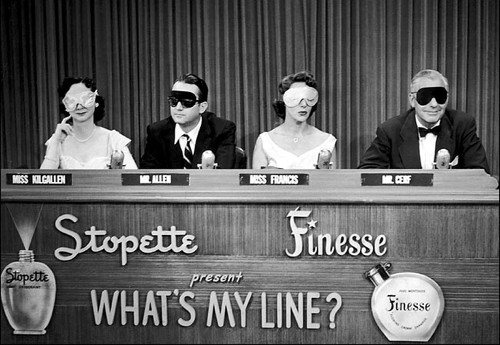
Above: 1952 ‘What’s My Line?’ with advertising for Stopette and Finesse. Finesse Flowing Creme Shampoo introduced in 1952 was also sold in a flexible squeeze bottle. The brand is currently owned by Lornamead Brands. Montenier also introduced Poof Deodorant Body Powder in a squeeze bottle in 1954.
Stopette was initially very successful but Montenier did not have a competitive advantage for very long. Other companies soon adopted the squeeze bottle idea or came up with other methods of application such as the roll-on and aerosol.
See also: Aerosol Cosmetics
Also, after 1947, aluminium chlorohydrate began to replace aluminium chloride as the antiperspirant of choice, which made Jules Montenier’s patented antiperspirant formulae redundant. Although he introduced other products – most notably Finesse Flowing Creme Shampoo – Jules Montenier sold his brands to Helene Curtis in 1956 and Stopette passed into history. Finesse on the other hand was developed by Helene Curtis into a complete range of hair-care products and the line is still around today.
The flexible squeeze bottle
Although squeeze bottle deodorants and antiperspirants gave way to stick, roll-on and aerosol sprays, Jules Montenier’s invention has proliferated into almost every other class of cosmetics. Tough, flexible, squeeze containers on the market today include shampoos and conditioners, face and body lotions, hand creams, suntan lotions and talcum powders and are a direct legacy of the pioneering work that he carried out.
Updated: 22nd January 2020
Sources
Laden, K. (1988). Introduction and history of antiperspirants and deodorants. In K. Laden & C. B. Felger (Eds.), Antiperspirants and Deodorants (pp. 1-13). New York: Marcel Dekker, Inc.
Meikle, J. I. (1995). American plastic: A cultural history. New Brunswick, NJ: Rutgers University Press.
Montenier, J. B. (1951). The Stopette story. Drug and Cosmetic Industry. 68(3), 314-315, 394-395.
Plechner, S. (1972). Antiperspirants and deodorants. In M. S. Balsam & E. Sagarin (Eds), Cosmetics: Science and Technology, (2nd ed, Vol 2, pp. 373-419). New York: Wiley-Interscience.
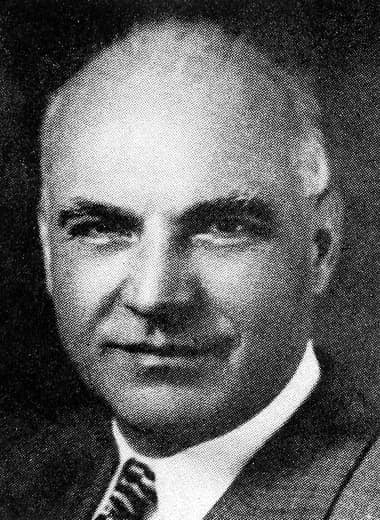
Dr. Jules Bernard Montenier [1895-1962].

1952 Design Patent USD157508 taken out by Jules Montenier.
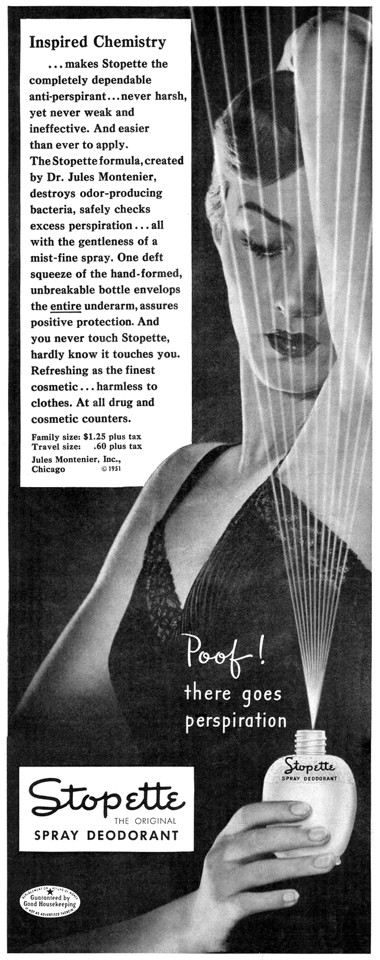
1951 Stopette Spray Deodorant.
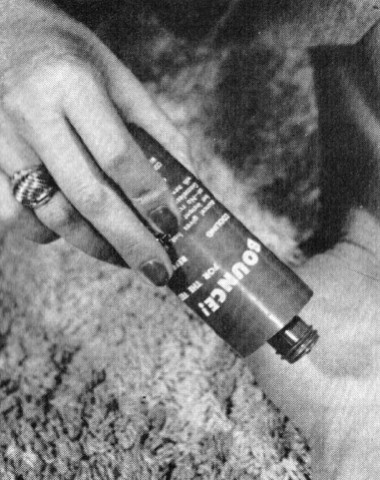
1952 Other plastic manufacturers were quick to develop the idea of the polyethylene squeeze bottle. In 1952, the Elmer E. Mills Corporation introduced the first plastic squeeze bottle that could be sprayed in an inverted position. It was first used to package Bounce!, a foot deodoriser that could be sprayed directly through stockings.
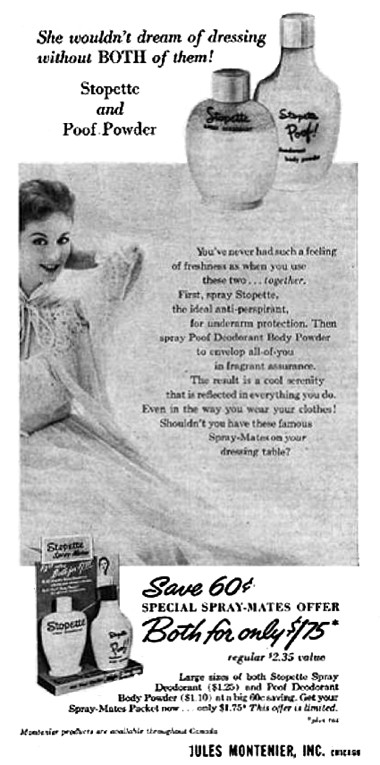
1954 Stopette Spray Deodorant and Poof Deodorant Body Powder.

1954 Plax Corporation. By 1950, Plax was making a hundred thousand squeeze bottles a day and planning to triple its capacity (Meikle, 1995, p. 190)
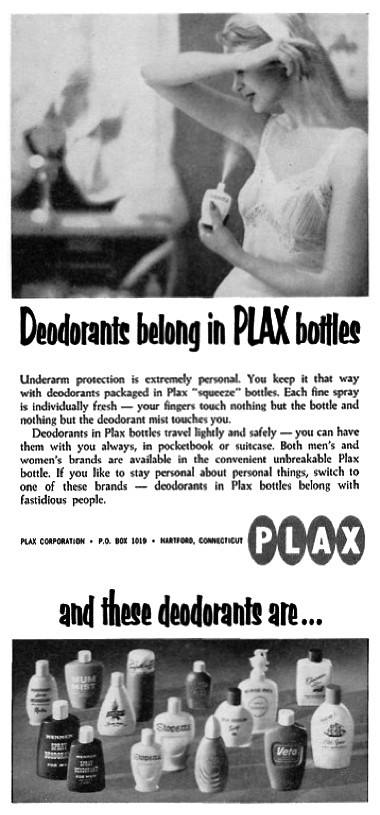
1957 Plax Corporation. Plax is now making squeeze bottles for a wide range of deodorants and antiperspirants.

1959 Shulton. One of many adaptations of the original polyethylene squeeze bottle.
